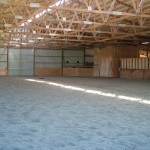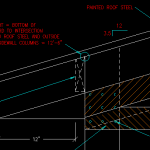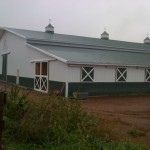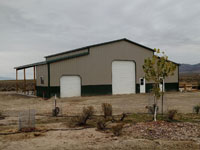DEAR POLE BARN GURU: My daughter has taken up roping, and I would like to build a covered arena so she can practice year round. Note I said covered, not enclosed. I am not sure I can afford an enclosed arena, but can a covered arena. My question is, what size should this be? I have read that 120 x 240 is the smallest. Also, she does poles and barrels. We would use the arena for this also.
thanks GEORGE in HOPKINSVILLE
 DEAR GEORGE: Having raised a “horse” daughter, I can empathize – it is not a hobby for the faint of pocketbook. In post frame construction, it is often more economical to cover some or all of the sides, rather than constructing just a roof. For roping, even the professionals usually stick to 70 to 80 foot widths and 18 foot eave heights, in order to keep the investment down. For barrel racing, 120 foot does seem to be the most common competitive width, however when faced with erected costs which can run easily upwards of a quarter of a million dollars compromises are usually made to fit within a more comfortable budget amount (again, usually going with a narrower width).
DEAR GEORGE: Having raised a “horse” daughter, I can empathize – it is not a hobby for the faint of pocketbook. In post frame construction, it is often more economical to cover some or all of the sides, rather than constructing just a roof. For roping, even the professionals usually stick to 70 to 80 foot widths and 18 foot eave heights, in order to keep the investment down. For barrel racing, 120 foot does seem to be the most common competitive width, however when faced with erected costs which can run easily upwards of a quarter of a million dollars compromises are usually made to fit within a more comfortable budget amount (again, usually going with a narrower width).
DEAR POLE BARN GURU: How do you figure per SQ FT how many nails you will need. MIKE in SIOUX FALLS
 DEAR MIKE: Square footage really has nothing to do with the number of nails needed. For 10d common framing nails, a general rule is five pounds for each 20 dimensional 2” lumber pieces. Nailing T1-11, wood or composite sheeting with 8d commons? Usually a pound will do about two 4’x8’ sheets. For joist hanger nails, conventional 2×6 hangers take a pound of 10d common x 1-1/2” nails for each eight hangers.
DEAR MIKE: Square footage really has nothing to do with the number of nails needed. For 10d common framing nails, a general rule is five pounds for each 20 dimensional 2” lumber pieces. Nailing T1-11, wood or composite sheeting with 8d commons? Usually a pound will do about two 4’x8’ sheets. For joist hanger nails, conventional 2×6 hangers take a pound of 10d common x 1-1/2” nails for each eight hangers.
Keep in mind these are merely approximations. Actual usage may vary due to specific building design requirements or individual installation techniques.
DEAR POLE BARN GURU: I’m looking at your 60×120 pole barn kit.
Is that a clear span? I’m planning on making a riding arena and not wanting poles in the riding area.
Thanks MIKE in ARDMORE
 DEAR MIKE: Unless you for some reason wanted to have interior columns, the 60’ x 120’ pole barn (post frame building) kit package would indeed be a clearspan. We can also provide wider, longer or a combination of the two. For more reading on perfect riding arenas: https://www.hansenpolebuildings.com/2012/07/the-perfect-indoor-riding-arena/.
DEAR MIKE: Unless you for some reason wanted to have interior columns, the 60’ x 120’ pole barn (post frame building) kit package would indeed be a clearspan. We can also provide wider, longer or a combination of the two. For more reading on perfect riding arenas: https://www.hansenpolebuildings.com/2012/07/the-perfect-indoor-riding-arena/.

 DEAR RALPH: From Chapter 14 of the Hansen Pole Buildings’ Installation Guide: Using a minimum 5/16” galvanized staple, staple through insulation to eave purlin top. As an alternative to staples, 1” galvanized roofing nails (with the big plastic washers) also work well.
DEAR RALPH: From Chapter 14 of the Hansen Pole Buildings’ Installation Guide: Using a minimum 5/16” galvanized staple, staple through insulation to eave purlin top. As an alternative to staples, 1” galvanized roofing nails (with the big plastic washers) also work well. I’m always on board (pun intended) for new, interesting and different ideas. This one certainly qualifies!
I’m always on board (pun intended) for new, interesting and different ideas. This one certainly qualifies!





